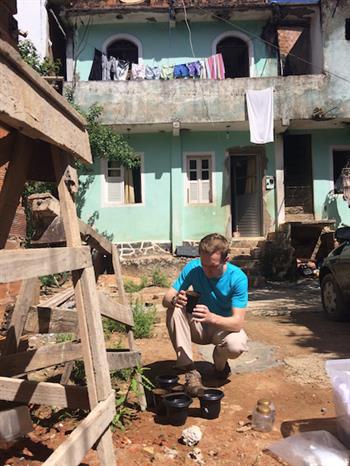
It’s early morning as Chris Roundy methodically checks the small black traps in a Galveston backyard, looking intently for the tiny treasures that might help scientists researching arboviruses, including Zika and dengue fever.
In this case, the treasures are mosquito eggs that Roundy hopes will line the textured paper that’s inside the traps. If he finds them, the eggs will be brought back to the Keiller Building lab where they will eventually hatch into mosquitoes to be used in experiments that researchers are conducting into the deadly viruses.
“Collecting local species of mosquitoes for use in lab testing is vitally important,” says Roundy, a second-year graduate student in UTMB’s Human Pathophysiology and Translational Medicine Program. “It’s critical that we have mosquito populations in our lab that are as fresh from the field as possible. If you bring mosquitoes into a lab and breed them through many generations, they may become different from the mosquitoes in the field in their ability to transmit viruses. If we really want to determine how these species transmit Zika, then we need to be looking at field-fresh mosquito populations.”
Since February, Roundy and his colleagues have placed 20 different types of mosquito traps near apartments and homes in Galveston to collect local mosquitoes that can be studied in the lab. While it’s still early in the season, as the temperature and humidity levels increase in the coming months, Roundy says they plan to have as many as 100 traps in operation across the island.
“We’d like to use satellite images of the island to determine different kinds of land use, whether it’s developed for housing or downtown centers or if it’s rural marshland,” Roundy said. "Then, we’ll survey each of those specific land uses and see what kinds of mosquito populations are there and determine if there’s a difference in those populations based on land use herein Galveston.”
Roundy said researchers are looking specifically at two urban species of the Aedesmosquito: aegypti and albopictus. It is believed the traps will help them determine which of the Aedes mosquito is more prevalent in Galveston.
“It’s usually presumed that aegypti has a stronger presence but that is only true in the U.S. along the Gulf Coast,” Roundy says. “If you were in the Midwest or further up on the East Coast, albopictus is more prevalent.”
Determining which species is more common is significant, Roundy says, because it is believed that aegypti is better at transmitting viruses including Zika and dengue fever.

Roundy says that back in the lab, researchers are infecting the trapped mosquitoes with Zika to determine how long it takes for them to start transmitting the virus and how good they are transmitting the virus and then comparing those outcomes with the same species from different countries, including Brazil and Thailand.
“We’re also testing different strains of the virus,” he says. “We have strains from the American outbreak, and we also have strains from older outbreaks in Cambodia and Dakar to see if there’s any combination of viral strain and mosquito strain that either hinders viral replication in the mosquito or enhances it. We’re not at the point to where we’ve seen that because we’re still ramping up these studies. But if we do see that, the obvious question would be, ‘Why?’”
Roundy believes the mosquito traps provide a valuable addition to researchers’ work with arboviruses by providing a fresh batch of field specimens for experiments.
“Ultimately, the work we’re doing is very relevant to problems in global health,” Roundy says. “Both chikungunya and Zika in recent years have shown how quickly an arbovirus can emerge into a naïve region and then just spread like wildfire.